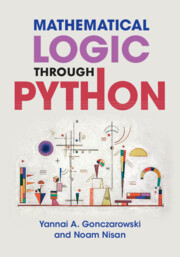Refine search
Actions for selected content:
48292 results in Computer Science
From theories on styles to their transfer in text: Bridging the gap with a hierarchical survey
-
- Journal:
- Natural Language Engineering / Volume 29 / Issue 4 / July 2023
- Published online by Cambridge University Press:
- 26 August 2022, pp. 849-908
-
- Article
-
- You have access
- Open access
- HTML
- Export citation
RoLEX: The development of an extended Romanian lexical dataset and its evaluation at predicting concurrent lexical information
-
- Journal:
- Natural Language Engineering / Volume 29 / Issue 3 / May 2023
- Published online by Cambridge University Press:
- 26 August 2022, pp. 720-745
-
- Article
- Export citation
Building better global data governance – CORRIGENDUM
-
- Journal:
- Data & Policy / Volume 4 / 2022
- Published online by Cambridge University Press:
- 26 August 2022, e27
-
- Article
-
- You have access
- Open access
- HTML
- Export citation

Mathematical Logic through Python
-
- Published online:
- 25 August 2022
- Print publication:
- 15 September 2022
Part I - Elements of Probability Theory
-
- Book:
- Principles of Statistical Analysis
- Published online:
- 22 July 2022
- Print publication:
- 25 August 2022, pp 1-2
-
- Chapter
- Export citation
21 - Regression Analysis
- from Part III - Elements of Statistical Inference
-
- Book:
- Principles of Statistical Analysis
- Published online:
- 22 July 2022
- Print publication:
- 25 August 2022, pp 329-355
-
- Chapter
- Export citation
3 - Distributions on the Real Line
- from Part I - Elements of Probability Theory
-
- Book:
- Principles of Statistical Analysis
- Published online:
- 22 July 2022
- Print publication:
- 25 August 2022, pp 34-40
-
- Chapter
- Export citation
Appendix: Mathematical Background and Notation
-
- Book:
- Bayesian Methods for Interaction and Design
- Published online:
- 18 August 2022
- Print publication:
- 25 August 2022, pp 335-360
-
- Chapter
- Export citation
Dedication
-
- Book:
- Principles of Statistical Analysis
- Published online:
- 22 July 2022
- Print publication:
- 25 August 2022, pp vii-vii
-
- Chapter
- Export citation
6 - Multivariate Distributions
- from Part I - Elements of Probability Theory
-
- Book:
- Principles of Statistical Analysis
- Published online:
- 22 July 2022
- Print publication:
- 25 August 2022, pp 68-77
-
- Chapter
- Export citation
17 - Multiple Numerical Samples
- from Part III - Elements of Statistical Inference
-
- Book:
- Principles of Statistical Analysis
- Published online:
- 22 July 2022
- Print publication:
- 25 August 2022, pp 271-288
-
- Chapter
- Export citation
10 - Sampling and Simulation
- from Part II - Practical Considerations
-
- Book:
- Principles of Statistical Analysis
- Published online:
- 22 July 2022
- Print publication:
- 25 August 2022, pp 127-137
-
- Chapter
- Export citation
Part IV - Bayesian Cognitive Modelling
-
- Book:
- Bayesian Methods for Interaction and Design
- Published online:
- 18 August 2022
- Print publication:
- 25 August 2022, pp 285-286
-
- Chapter
- Export citation
Part I - Introduction to Bayesian Methods
-
- Book:
- Bayesian Methods for Interaction and Design
- Published online:
- 18 August 2022
- Print publication:
- 25 August 2022, pp 1-2
-
- Chapter
- Export citation
7 - Expectation and Concentration
- from Part I - Elements of Probability Theory
-
- Book:
- Principles of Statistical Analysis
- Published online:
- 22 July 2022
- Print publication:
- 25 August 2022, pp 78-99
-
- Chapter
- Export citation
Part II - Practical Considerations
-
- Book:
- Principles of Statistical Analysis
- Published online:
- 22 July 2022
- Print publication:
- 25 August 2022, pp 125-126
-
- Chapter
- Export citation
Contents
-
- Book:
- Principles of Statistical Analysis
- Published online:
- 22 July 2022
- Print publication:
- 25 August 2022, pp ix-xiii
-
- Chapter
- Export citation
8 - Convergence of Random Variables
- from Part I - Elements of Probability Theory
-
- Book:
- Principles of Statistical Analysis
- Published online:
- 22 July 2022
- Print publication:
- 25 August 2022, pp 100-112
-
- Chapter
- Export citation
Contributors
-
- Book:
- Bayesian Methods for Interaction and Design
- Published online:
- 18 August 2022
- Print publication:
- 25 August 2022, pp vii-viii
-
- Chapter
- Export citation
